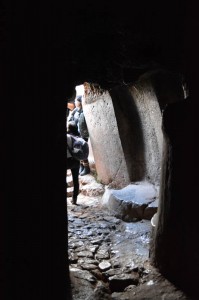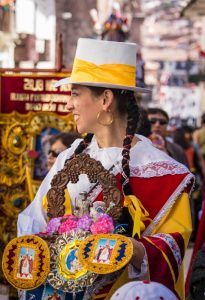One Taxi Ride in Cuzco

Two people dressed as Incas stepped to the street corner as a taxi i was in turned there. I said to the driver. “More Incas!” More and more you are seeing people wearing Inca costume on the streets of Cuzco as businesses and entrepreneurs find it ever more useful to provide a visualization of Incas for visitors and locals, removing them from the domain of the storied or mythical and making them seem as real as, say, spiderman when he appears on the streets.
We then spoke about how would it be if a real Inca could come through a time machine to see current day Cusco or it we could go back to those times. We agreed that the language and ways of today would be different and perhaps unintelligible for someone from then. He said that the Quechua spoken today differs greatly from that of the ancestors.
Feeling all smug with my knowledge of what people say here I claimed “Incas are alive, I am told, in the Chincanas and underground. They turn people back when they try to go there.”

“That is not true!”, He replied. “How can they still be alive after so many years. People just imagine them. Those are stories not real. They are imaginings. People see them in their minds.”
Now far less smug, I said: “But people say they see machulas” (ancestors or ancient ones.

“Yeah, they see them with their minds, It is their belief.”
“What about bones? People say they are still alive. Many people have skulls in their houses and they say they are alive.”
“That is because the bone still keeps part of the person’s spirits. They are just spirits. It is not the bone, but the spirit that is alive.”
“What kind of spirits are they. I mean people talk about two kinds of spirits, like the one that stays when you fall down or get a sudden surprise or a shock. You know the one that people go to healers to get to return to them. They also say there is an alma, a soul.”
“These are just spirits; the souls are taken by God. but they are invisible. Only the bone is visible. You just maybe see a glimmer in the air.”
“I have heard people say that when someone is going to die or has died they send a moth to visit you to say goodbye. The moth is the person’s spirit they say.”

“Yes, they do say that. A bird or a moth can come as the person’s spirit to let people know. Otherwise spirits are invisible. They are like air. You cannot see air but it is there. When some one dies you see that change in the air that says that their spirit is leaving their body. They are like ghosts. Do you know about ghosts?
“They are not visible, kind of like God. I do not believe in the saints. People pray to them, but they are not real. They are just statues. I believe in God. God above all. You can always pray directly to God. You can go to the top of the mountains at twelve noon or twelve midnight to make your petition. He will hear it and answer it.”
“Are you Evangelical?”
“No. I am Catholic but since I was nine years old I have not believed in the saints. They make no sense to me.”
“Where did you grow up?”
“I am from Chumbivilcas. My mother and everyone believed in the saints and made them offerings. But I did not like it since I was a little boy.”

“What do you do about the fiestas and the jurkas, (the requests to help with feast sponsorship? Do you participate in them?”
“Yes. I do. But I do not do the cargos (assume the responsibility for a feast, including giving devotion to a saint). If someone jurkars me I accept. That is not about the saint, it is about helping someone who is a friend and being a good member of society, It is just something you should do.”
“Like ayni (Andean reciprocity)?”
“Exactly. It is ayni and that is what keeps society going.”
My stop arrived. He told me his name and I shared mine along with a handshake. I paid him the fare and got off, my head spinning from the richness of the conversation and the diversity of thought and practice in Cuzco around its central institutions.




